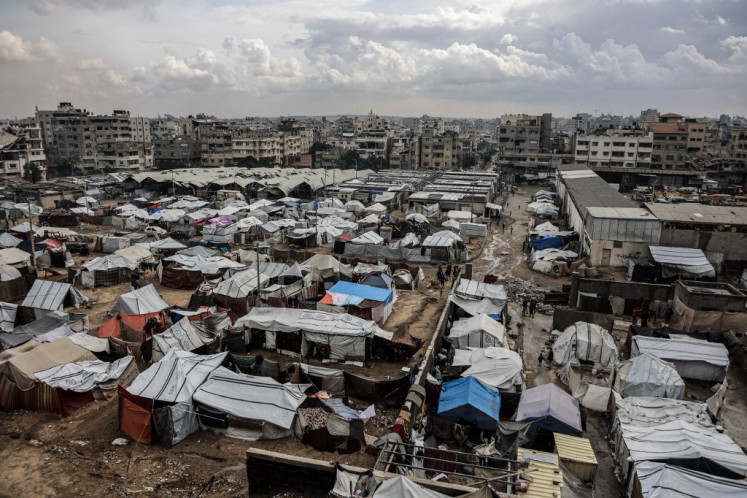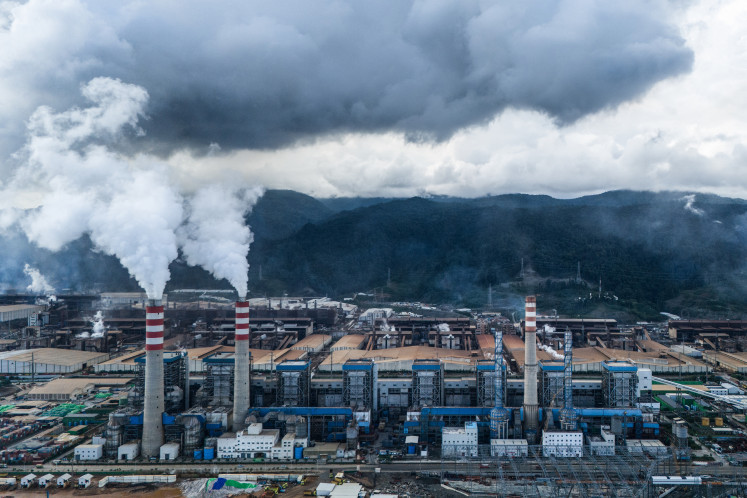Popular Reads
Top Results
Can't find what you're looking for?
View all search resultsPopular Reads
Top Results
Can't find what you're looking for?
View all search resultsDUST TO DUST: Ancient relics reduced to rubble
Piece of History: Fragments of pottery and ceramics hint at life in the ancient civilizations in the Kremes area, although lack of funding and legal protection mean archaeologists have little opportunity to learn more
Change text size
Gift Premium Articles
to Anyone
Piece of History: Fragments of pottery and ceramics hint at life in the ancient civilizations in the Kremes area, although lack of funding and legal protection mean archaeologists have little opportunity to learn more. (JP/J.B. Djwan)
A 2,000-year-old sarcophagus lies in pieces where it fell, protected from the elements and scavengers by yellow police tape and a blue tarpaulin.
Excited, curious kids duck under the yellow plastic strip and wander through the rubble, blissfully unaware the ground they tread on is strewn with ancient bone fragments from the stone coffin.
Half-baked: Workers at the brick-making site where a 2,000-year-old sarcophagus was found, earn about US$3.20 a day. One archaeologist believes workers could earn a better living through the preservation of the ancient site. (JP/ J.B Djwan)
The sarcophagus, discovered earlier this month in a brick-making site in Kremes, Gianyar, was finally transferred to Bali’s antiquities museum last Friday.
Gusti Putu Wida, the Balinese worker who accidentally broke the ancient artifact, said he was unaware the stone was a sarcophagus.
“I came to work at 6 p.m., the light was bad and I saw this stone. I thought it’d be good for making a statue. When I broke it open and saw the bones, I looked to see if there was anything else in the tomb. There were just bones,” he said, adding he had yet to receive a reward for discovering and reporting the ancient grave.
The skeleton preserved in this mudstone coffin for at least two millennia is now little more than a collection of bone shards, jumbled up with offerings of flowers and rice. No skull or teeth remain, although long bones – bits of legs and arms – have been found meters from the site. There is little chance of reconstructing the skeleton or of determining its age and sex.
Near the bones were hundreds of pottery and porcelain fragments. Stepping through the quarry is delicate, as any move could damage these fragmented remains of Indonesia’s ancient past.
None of the workers here can begin to guess at the age of the pottery fragments, these whispers of a former civilization, some more than 20 centimeters long. Are they remnants of an ancient kingdom, a burial ground or the palace kitchens? The more prosaic suggest they are just the discards of a more recent pottery factory.
The sarcophagus suggests this may be the burial ground of a Balinese monarch whose story has been lost in time.
Locals say the region was once known as Abang, but the community moved hundreds of years ago to Desa Abang. The villagers return annually to pay homage to their ancestral home.
Archaeologists from the government’s Bali Archaeology office in Denpasar have given different dates to the different shards found.
“The Chinese porcelain dates from the Song Dynasty to the Ching Dynasty. There may also be Tang Dynasty ware here,” says archaeologist A.A. Olea Astawa, setting dates for the porcelain shards at between 1100 CE (Common Era) and 1600 CE.
The terracotta is even older according to prehistory expert, Citha Yuliati. “These shards date from 2500 BCE [Before the Common Era] onward, Indonesia’s Bronze Age. This site also has megalithic artifacts that date from, possibly, before 3000 BCE. This is an important site.”
Stone-age artifacts found so far include a stone axe and a smooth, carved oblong stone, a likely offering to the gods.
But studies at the site may never take place. Archaeologists are hamstrung by a lack of funding and political will. There is simply no money to halt the brick-making and set up a project to investigate and preserve evidence from potentially 5,000 years of continuous human endeavor.
“This breaks our hearts,” Yuliati said. “In Kremes there are many sites like this. More than 10 sarcophagi have been unearthed to date. This new site is very rich.”
In most countries, sites such as Kremes would be sealed off for protection. Archaeologists and their students could then begin the painstaking excavation process, extracting and documenting one artifact at a time, to discover more about who these ancient people were, how they lived and what they might teach us now.
Although there are many institutions to help with ancient artifacts, including UNESCO, applying for funding is outside the sphere of the Bali Archaeology office.
“Jakarta has to do that because we’re just a branch [office],” Yuliati said. “Our hands are tied.”
The Kremes sites, although comparable to Egyptian or Mayan sites in importance, are not given
the same respect granted those ancient civilizations. Instead, the priceless remains of Indonesia’s burial sites are treated like worthless rubble. As one worker at the site said, “We find these old bits of pottery all the time. We just throw them in the rubbish.”
The workers are hardly to blame. They earn US$3.20 a day making bricks; the detritus of history is just a nuisance that slows them down.
“No, I’m not careful. We see broken bits of pottery all day. We know they’re old, but I have to keep working to make money,” one brick maker said. He and his wife work together to produce on average 600 bricks a day.
Here, where the workers live and work on site, there is no room for the luxury of history. Day in, day out they quarry clay from the hill, mix it with water and earth and form bricks to set out to dry.
Last year, Kristiawan, an archaeologist from Denpasar’s Udayana University, worked on the excavation of the Trowulan Majapahit site in East Java, turning up hundreds of terracotta, stone and ceramic vessels and metal dies. That site was recently damaged by a government project building a cultural center.
Indonesia’s laws on potential sites of antiquity provide inadequate protection and state that owners of land where artifacts are found are the legal owners of those artifacts. The constraint is that if landowners want to keep the artifacts they must restore them and leave them in situ, safely housed – a tall order for a brick-making site. They are also forbidden to sell the artifacts or damage them.
The irony, as Kristiawan sees it, is that the brick workers could actually do better by preserving these artifacts.
“Sites such as Kremes could be supported by tourism,” he said. “People around the world would come to see the unique culture and history of Indonesia.”











